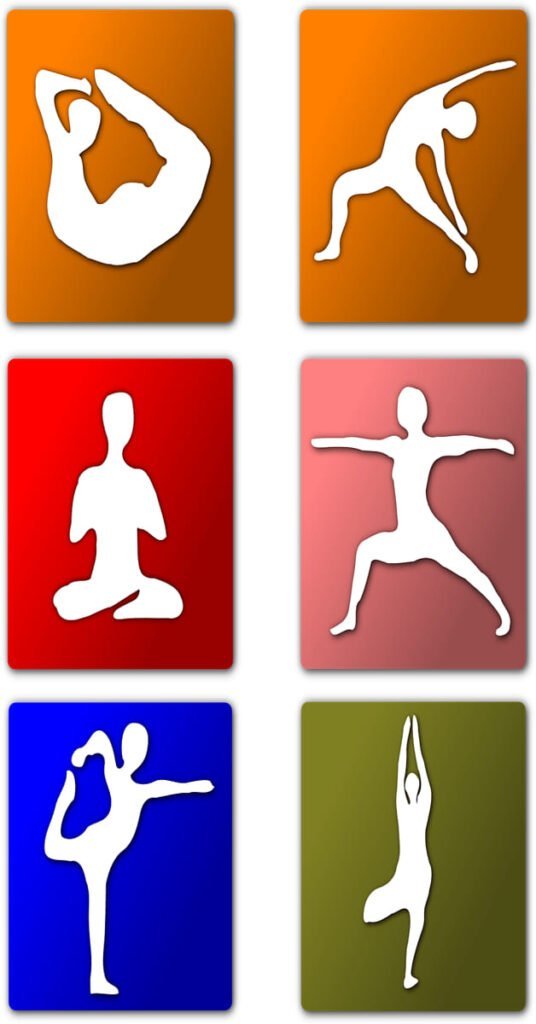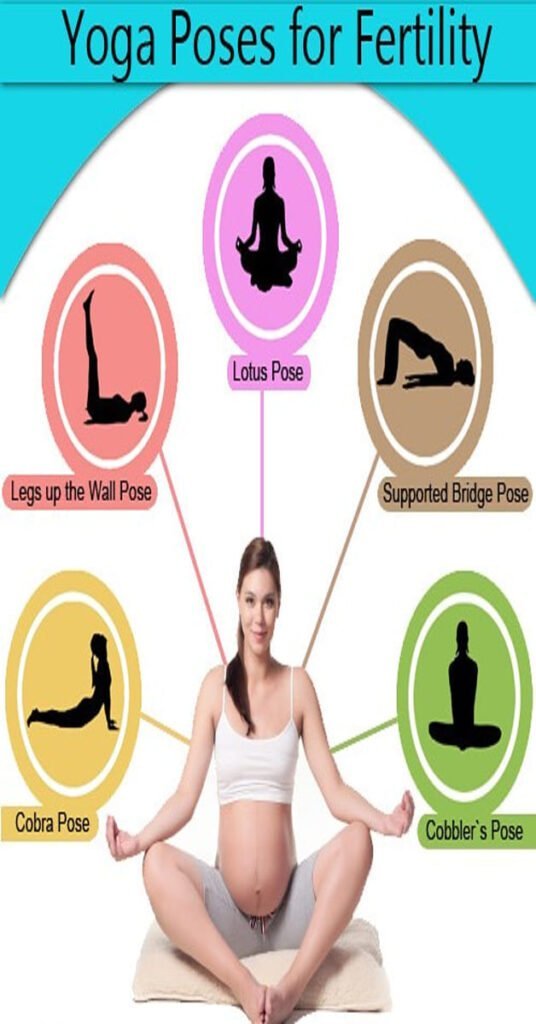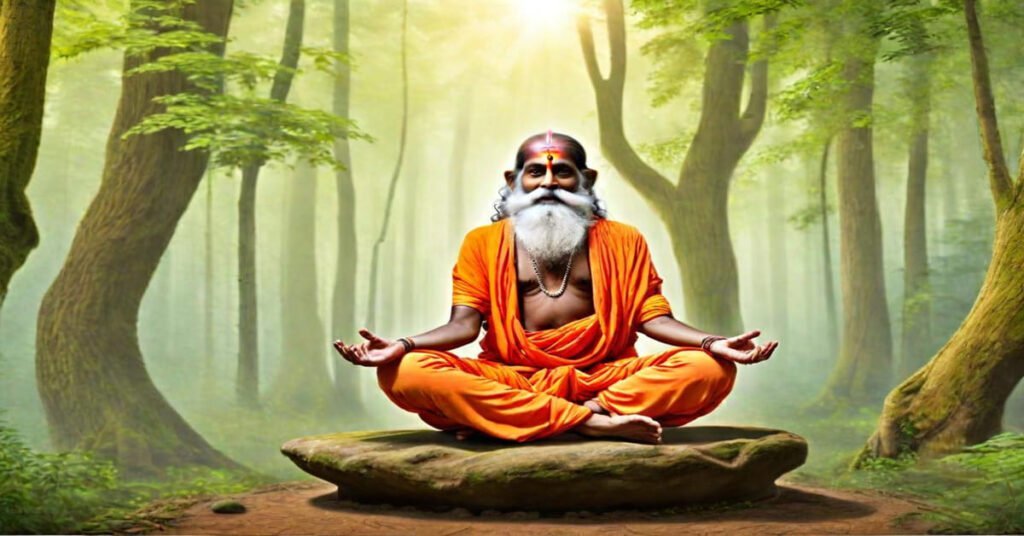Yoga Through the Ages From Ancient Wisdom to Modern Wellness – Exploring Origins, Evolution, and Traditions in a Journey of Harmony and Unity.

Yoga is a set of practices that originated in ancient India, aiming to bring harmony to the body, mind, and spirit. The word “yoga” means “union” or “yoke,” signifying the union of individual consciousness with universal consciousness. It encompasses physical exercises, mental techniques, and spiritual disciplines.
The roots of yoga can be traced back to ancient Hindu scriptures like the Rigveda and Upanishads, where references to yoga-like practices are found. The term “yoga” was first mentioned with its current meaning in the Katha Upanishad, dating back to the 5th to 3rd centuries BCE. Over time, yoga evolved into a systematic study and practice, particularly during the ascetic movements in ancient India.

Here’s some guidance for beginners starting with yoga:
- Start Slow: Begin with basic poses and gradually progress to more challenging ones as you build strength and flexibility.
- Focus on Breathing: Pay attention to your breath during each pose. Deep, steady breathing helps you relax and enhances the benefits of yoga.
- Listen to Your Body: Honor your body’s limitations and don’t push yourself too hard. Yoga is about self-awareness and self-care.
- Use Props: Props like blocks, straps, and bolsters can assist you in maintaining proper alignment and ease into poses comfortably.
- Find a Qualified Teacher: Consider taking classes from a certified yoga instructor who can guide you safely through the practice.
- Consistency is Key: Aim for regular practice, even if it’s just a few minutes a day. Consistency helps you progress and reap the full benefits of yoga.
7. Stay Present: Focus on the present moment during your practice, letting go of distractions and thoughts about the past or future.
8. Stay Hydrated and Nourished: Drink water before and after your practice, and eat a light meal or snack if needed before you begin.
9. Rest and Recover: Incorporate restorative poses and relaxation techniques into your practice to help your body recover and rejuvenate.
10. Enjoy the Journey: Approach your yoga practice with curiosity and openness. Embrace the journey of self-discovery and enjoy the physical, mental, and emotional benefits along the way.
The Yoga Sutras of Patanjali, written in the early Common Era, are considered one of the most comprehensive texts on yoga philosophy. Yoga philosophy became established as one of the six orthodox schools of Hinduism in the first millennium CE.
There are two main theories about the origins of yoga. The linear model suggests that yoga originated during the Vedic period and influenced Buddhism. The synthesis model proposes that yoga is a blend of Vedic and non-Vedic elements.
Here’s some guidance on yoga poses:
- Mountain Pose (Tadasana): Stand tall with feet hip-width apart, arms at your sides, and shoulders relaxed. Engage your core and lengthen through the spine, reaching the crown of your head toward the sky.
- Downward-Facing Dog (Adho Mukha Svanasana): Start on your hands and knees, then lift your hips up and back, forming an inverted V-shape with your body. Press your palms into the mat and keep your heels reaching toward the ground.
- Warrior I (Virabhadrasana I): Step one foot back into a lunge position, with the front knee bent at a 90-degree angle and the back leg straight. Square your hips forward, reach your arms overhead, and gaze up toward your hands.
- Warrior II (Virabhadrasana II): From Warrior I, open your hips and shoulders to the side as you extend your arms out parallel to the floor. Keep your front knee bent and aligned with your ankle, with your gaze over your front hand.

5. Tree Pose (Vrksasana): Stand on one leg and place the sole of your other foot on the inner thigh or calf of the standing leg. Press your foot into your thigh or calf while maintaining balance, and bring your hands together at your heart center or extend them overhead.
6. Child’s Pose (Balasana): Kneel on the mat, then sit back on your heels and fold forward, bringing your forehead to the ground and arms extended in front or resting alongside your body. Relax your forehead, neck, and shoulders.
7. Cobra Pose (Bhujangasana): Lie on your stomach with your palms flat on the ground next to your chest. Press into your hands to lift your chest and head off the mat, keeping your elbows close to your body and shoulders relaxed.
8. Seated Forward Bend (Paschimottanasana): Sit on the mat with legs extended in front of you. Hinge at the hips to fold forward, reaching for your feet or shins with your hands. Keep your spine long and lead with your heart.
9. Corpse Pose (Savasana): Lie flat on your back with arms and legs extended, palms facing up. Close your eyes and relax your entire body, letting go of tension in muscles and allowing your breath to flow naturally.
10. Cat-Cow Pose (Marjaryasana-Bitilasana): Start on your hands and knees in a tabletop position. Inhale as you arch your back, lifting your chest and tailbone for Cow Pose. Exhale as you round your back, tucking your chin to your chest for Cat Pose. Repeat, flowing smoothly between the two poses.
In the Western world, “yoga” commonly refers to a modern form known as Hatha yoga, which focuses on physical postures (asanas) for fitness, stress relief, and relaxation. This differs from traditional yoga, which emphasizes meditation and spiritual liberation. Hatha yoga gained popularity in the West after Indian gurus, influenced by Swami Vivekananda, introduced it in the late 19th and early 20th centuries.

Here’s some guidance on the benefits of yoga:
- Physical Health: Yoga improves flexibility, strength, and balance. Regular practice can help reduce the risk of injury, improve posture, and increase overall physical fitness.
- Stress Reduction: Yoga promotes relaxation and stress relief through deep breathing and mindfulness techniques. It helps calm the mind, lower cortisol levels, and alleviate symptoms of anxiety and depression.
- Mental Clarity: Yoga enhances mental focus and concentration by encouraging present-moment awareness. It can improve cognitive function, memory, and overall mental clarity.
- Emotional Well-being: Yoga cultivates emotional resilience and self-awareness, allowing practitioners to better cope with life’s challenges. It promotes a sense of inner peace, contentment, and emotional balance.
5. Improved Sleep: Practicing yoga regularly can help regulate sleep patterns and improve the quality of sleep. Relaxation techniques and mindful breathing promote deep relaxation, making it easier to fall asleep and stay asleep.
6. Boosted Immunity: Yoga supports a healthy immune system by reducing inflammation, promoting circulation, and enhancing the body’s natural defense mechanisms. It can help prevent illness and promote faster recovery from illness or injury.
7. Pain Management: Yoga can be an effective tool for managing chronic pain conditions such as back pain, arthritis, and migraines. It increases flexibility, strengthens muscles, and improves posture, reducing strain on the body and alleviating pain.
8. Increased Energy: Regular yoga practice boosts energy levels by improving circulation, oxygenating the body, and reducing fatigue. Dynamic yoga sequences can invigorate the body and mind, leaving practitioners feeling energized and revitalized.
9. Enhanced Self-awareness: Yoga encourages self-reflection and introspection, deepening the connection between mind, body, and spirit. It fosters self-awareness, self-acceptance, and a greater sense of inner peace and harmony.
10. Community and Connection: Yoga provides an opportunity to connect with like-minded individuals and build a supportive community. Group classes, workshops, and retreats offer a sense of belonging and connection, fostering friendships and social support networks.
Overall, yoga has evolved over thousands of years, adapting to various cultural contexts and gaining recognition as a holistic practice for physical, mental, and spiritual well-being.
Here’s an introduction to some different types of yoga:
- Hatha Yoga: Hatha yoga is a traditional form of yoga that focuses on physical postures (asanas) and breathing techniques (pranayama). It emphasizes balance, strength, and flexibility, making it suitable for beginners.
- Vinyasa Yoga: Vinyasa yoga, also known as flow yoga, involves flowing sequences of poses coordinated with breath. It’s a dynamic and fluid practice that builds strength, endurance, and mindfulness.
- Yin Yoga: Yin yoga is a slow-paced style of yoga that targets the connective tissues, such as ligaments, tendons, and fascia. Poses are held for longer periods, typically 3-5 minutes or more, to encourage deep relaxation and release tension.
- Restorative Yoga: Restorative yoga focuses on relaxation and rejuvenation, using props like blankets, bolsters, and blocks to support the body in gentle poses. It’s designed to promote deep rest and stress relief, making it ideal for relaxation and healing.
- Iyengar Yoga: Iyengar yoga emphasizes precision and alignment in poses, using props to help students achieve correct form. It’s a methodical and detail-oriented practice that is accessible to practitioners of all levels.
- Ashtanga Yoga: Ashtanga yoga is a dynamic and physically demanding practice that follows a specific sequence of poses linked with breath. It’s known for its rigorous structure and progressive series of postures, promoting strength, flexibility, and stamina.
- Kundalini Yoga: Kundalini yoga focuses on awakening the energy at the base of the spine (kundalini) through a combination of dynamic movements, breathing techniques, chanting, and meditation. It’s a spiritual and transformative practice that aims to cultivate awareness and vitality.

8. Bikram Yoga: Bikram yoga, also known as hot yoga, consists of a series of 26 poses practiced in a room heated to a high temperature. The heat enhances flexibility and detoxification, while the sequence provides a full-body workout.
9. Jivamukti Yoga: Jivamukti yoga is a modern yoga style that integrates physical postures with spiritual teachings, music, chanting, and meditation. It’s a dynamic and creative practice that emphasizes environmentalism, veganism, and social activism.
10. Power Yoga: Power yoga is a vigorous and athletic style of yoga inspired by Ashtanga and Vinyasa yoga. It focuses on building strength, stamina, and flexibility through fast-paced sequences and challenging poses.
Navigating the Rich Tapestry of Yoga A Journey from Ancient Origins to Modern Revival
Embark on an enriching voyage through the vibrant history and contemporary resurgence of yoga, a timeless practice that continues to captivate enthusiasts worldwide. In this comprehensive exploration, we’ll delve into the etymology, definitions, goals, and pivotal moments that have shaped the evolution of yoga, offering insights to both seasoned practitioners and curious newcomers.
History: The history of yoga is rich and spans thousands of years, originating in ancient India. While the exact origins of yoga are debated among scholars, it is believed to have evolved over several millennia, with roots in ancient Indian scriptures and traditions.

- Prehistoric Origins: The earliest evidence of yogic practices dates back to the prehistoric Indus Valley civilization, around 3000 BCE. Archaeological findings, such as seals depicting figures in yoga-like poses, suggest that yoga may have been practiced in this ancient civilization.
- Vedic Period (1500–500 BCE): The Vedic texts, including the Rigveda, contain hymns and rituals that suggest early forms of meditation and spiritual practices. Yoga is mentioned in the Rigveda, although in a broader context referring to spiritual discipline and inner control.
- Upanishadic Period (800–200 BCE): The Upanishads, philosophical texts that explore the nature of reality and the self, contain teachings on yoga as a means of self-realization and liberation (moksha). This period saw the development of various yogic concepts, such as karma (action), dharma (duty), and reincarnation.
- Classical Period (500 BCE–800 CE): The classical period of yoga saw the codification and systematization of yogic practices. The Yoga Sutras of Patanjali, compiled around the 2nd century CE, is one of the most influential texts on classical yoga philosophy. It outlines the eightfold path of yoga (Ashtanga yoga), which includes ethical guidelines (yamas and niyamas), physical postures (asanas), breath control (pranayama), and meditation (dhyana).
- Post-Classical Period (800–1700 CE): During this period, various schools of yoga emerged, each emphasizing different aspects of the practice. Tantra yoga, for example, focused on ritual practices and energetic techniques to achieve spiritual awakening. Hatha yoga, which arose around the 9th century CE, emphasized physical postures, breath control, and purification practices.
- Modern Period (Late 19th Century–Present): The modern period of yoga saw the spread of yoga to the West and the emergence of various yoga styles and traditions. Swami Vivekananda, a prominent Indian yogi, introduced yoga to the West in the late 19th century, sparking interest in Indian philosophy and spirituality. In the 20th century, figures such as T. Krishnamacharya, B.K.S. Iyengar, and K. Pattabhi Jois played key roles in popularizing yoga and developing modern yoga styles such as Vinyasa, Iyengar, and Ashtanga yoga.
Throughout its history, yoga has evolved and adapted to different cultural and religious contexts, but its underlying goal of spiritual growth and self-realization remains central to its practice. Today, yoga is practiced worldwide and continues to evolve, with practitioners exploring new styles, techniques, and applications of this ancient tradition.

References:
- Feuerstein, Georg. “The Yoga Tradition: Its History, Literature, Philosophy and Practice.” Hohm Press, 2001.
- Singleton, Mark. “Yoga Body: The Origins of Modern Posture Practice.” Oxford University Press, 2010.
- White, David Gordon. “The Yoga Sutra of Patanjali: A Biography.” Princeton University Press, 2014.
- Mallinson, James, and Mark Singleton. “Roots of Yoga.” Penguin Classics, 2017.
- Deshpande, Madhav. “Yoga for Transformation: Ancient Teachings and Practices for Healing the Body, Mind, and Heart.” Sounds True, 2018.
These references provide comprehensive insights into the historical, philosophical, and practical aspects of yoga, offering valuable information for further exploration and study.